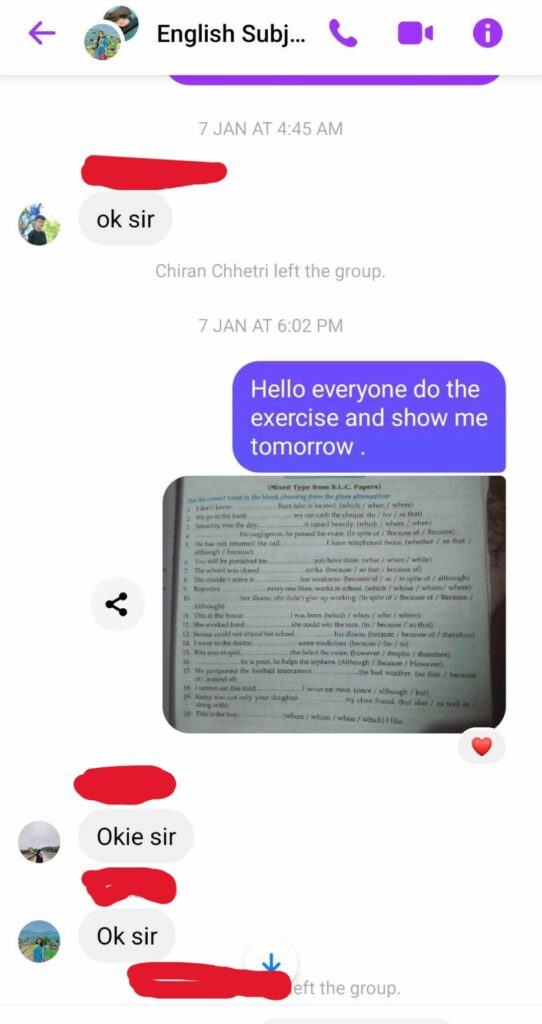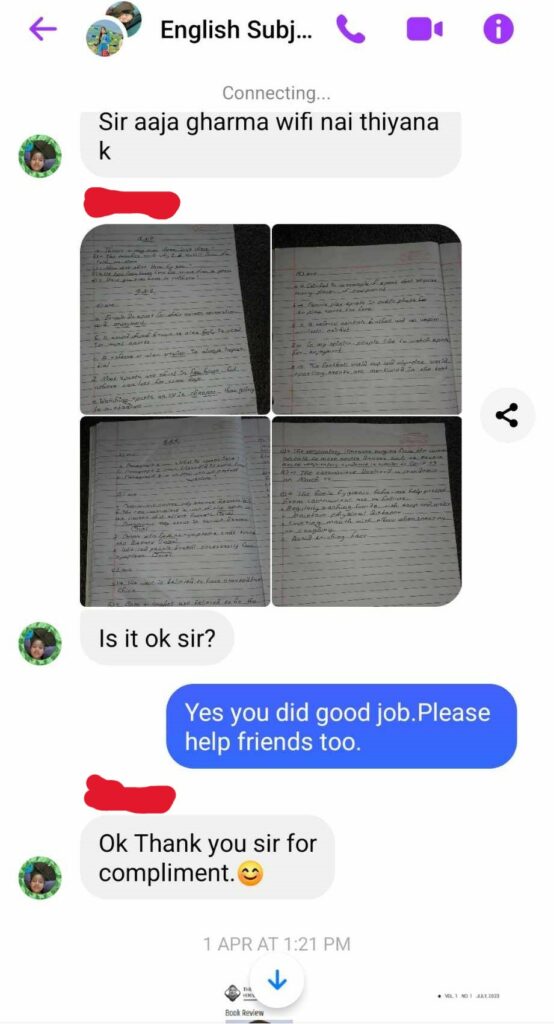
I have been teaching English at the basic to secondary level at government schools for more than a decade. With the advancement of technology, I have observed that teachers and parents have perceived that students are less engaged in reading textbooks and books. They think that students are more engaged in playing virtual games or using social media on their phones rather than completing assignments or engaging themselves with educational materials. Both teachers and parents have raised the question whether the ubiquitous presence of mobile phones has been a curse or a boon for students. In my perspective, it is a supporting device for them. In today’s society, it has become a fundamental tool for students to access information, communication, entertainment, and knowledge. However, by only engaging on mobile phones for games and fun can be counterproductive to their study. So, a serious question always hits me: if they like to engage on their devices, why not integrate the devices in their study. So, I created a messenger group with my students to integrate technology in their study. In this blog post, I am going to share my practices and reflect upon them.
Messenger group to integrate technology in low-resourced contexts
Schools came to closure during the COVID-19 pandemic, which brought many challenges for my colleagues and students. I was pensive as I was in a dilemma about my teaching profession. As there were no chances of opening schools, schools came up with the idea of opening learning centers across students’ communities. My colleague and I visited learning centers twice a week to assign homework package but that was not sufficient for secondary-level students. We could only accommodate 25 students in one learning center because of health protocols. During our visits, we would grade their homework, provide feedback, teach them challenging contents and assign homework for next week. I explored some of them having mobile phones and internet access at their home though a few did have access to the internet. However, they would manage to go to their peers’ house to access the internet. My observation revealed that most students were already familiar with mobile phones, they only required some ideas about using the devices for their study. Despite some limitations, I proceeded with the messenger group initiative, recognizing its potential to bridge the gap in access to educational resources and take students beyond textbooks to explore knowledge. Then I created a class messenger group and invited them to join. The group was a convenient forum for us to share resources, interact, communicate and learn. I shared study materials and assignments, and they were able to go through

them at their own pace and time even though it was impossible to meet in school due to the pandemic. It also helped students to get some ongoing support and resolve questions as I would respond to their questions and concerns.
My approach of engaging students in their study through technology aligns with flipped learning (Flipped Learning Network, 2014) which is one of teaching approaches in classrooms today. In flipped learning, teachers provide concepts to students using either videos, audio, or presentation apps, so that students study the contents and prepare before class (Al- Samarraie et al., 2020). So that in the classroom they can spend their time collaborating with teachers and other friends to advance their knowledge and understanding about the contents, which makes the classroom activities and time more productive. In my case, I did not record and share audio and videos, instead, I used texts and visuals to summarize texts and exercises and assign the tasks to them. I also used PowerPoint slides, text, snipping tools, movies, interesting Ted Talks, Benime apps, and other tools to facilitate teaching-learning. I joined workshops offered by some teachers’ associations to enhance my knowledge and skills in using ICT in my classrooms.
I continued using the messenger group even after the pandemic. I used the forum to share the contents and assignments of the day beforehand so the students would be familiar with the contents and become prepared for the class. Then they would share their ideas too by engaging in different kinds of activities in real class. Gradually, they became

interested and accustomed to studying the shared materials and completing their homework on time. It also helped them to learn independently as they could learn in their own way at time and place. They also used the messenger group as a forum to ask follow-up questions about things they did not understand in class. I would reply and confirm the answer in the group, and they would share ideas and work with me and their peers.
Benefits of flipped teaching
Flipped classroom vs traditional classroom
Flipped teaching is one of novel approaches where contents are shared before class with tasks assigned. Hariri et al. (2021) have illustrated that flipped learning is one of the recent and effective approaches that increase students’ interactivity and enhance the understanding of content in foreign language classrooms. I also observed some noticeable differences in student engagement and performance between traditional classroom settings and the flipped teaching approach. Unlike traditional classrooms, in flipped classes, students get direct access to knowledge with flexible contents and instructions. It was student-centered, making them active in the learning process and they were interested in studying by using mobile devices, whereas traditional classrooms are more teacher-centered where students would get less chances to interact with their teachers and peers. Similarly, they would get extra time to do their tasks and share their perspectives unlike traditional classes. In the same way, flipped teaching created an equitable opportunity for performing the tasks for students with diverse backgrounds as they would be able to study contents at their own time and pace. I also noticed that students became more independent in doing their assignments.
Benefits for my students
Parents and teachers blamed students for spending too much time on their devices and with our virtual forum, they also used their devices for study purposes. One interesting observation I made was that those who had previously neglected reading began showing interest and followed up for classroom assignments with their friends in the messenger group. Additionally, some of the students shared their work in the group. Similarly, students who had difficulty with exercises were able to comprehend complex questions

and share answers due to conversation and scaffolding in the group. Even absentees shared their assignments in class as the class materials and homework were shared through the group. The class had various student types, including shy ones, who felt comfortable expressing curiosity to teachers and developed a habit of engaging with messages and reading contents. It boosted their confidence, heightened reading awareness, and accelerated learning via social media.
Benefits for teacher
I used the virtual group to share some learning materials including content-related videos, PowerPoint slides, books, and podcasts online in advance which helped them to understand assigned materials and get ready for the next class. It also helped them in following home assignments as they could ask follow-up questions, leave their comments, and share their learning. It was also convenient for me to follow them up for their assignment through messenger. Likewise, I reused the materials and resources for other classes, so that I did not have to create another set of materials again. Embracing new technology, I further developed my teaching skills and sparked my interest in using technological tools.
Some challenges of flipped teaching
Although I was able to build a virtual students’ community to support each other in their learning, my students and I faced some challenges. Students, especially from remote parts, faced some difficulties in the internet connection. Students with internet access joined the group, but not everyone did. Those without internet access used mobile data, which proved costly and sometimes caused issues with downloading materials. Consequently, some were initially not involved in the messenger group, while others, despite being in the group, showed little interest. Gradually a few student ambassadors’ word-of-mouth brought more students back to the group and they started engaging in conversation and submitting their assignments through it. Additionally, it was a little challenging for me to make sure that they did not post irrelevant materials and messages to the group. So, the takeaway is to orient students to the dos and don’ts of virtual forums in the classroom.
Closing thoughts
Flipped classroom teaching through messenger groups is one of the recent teaching approaches that I adopted in my classroom. It can cater to multiple learning styles of students as it opens up both synchronous and asynchronous doors of learning. In my experiences, it has been valuable for both teacher and students as it helped me to share digital resources which are not possible to share in the classroom due to lack of technology. Moreover, I was able to clarify their doubts and confusion through the group chat. Students also had opportunities for collaboration, conversation and acquiring knowledge through shared resources independently. It was helpful in making students independent in their study and confident in expressing their ideas. Additionally, I was able to teach them how they can use their mobile devices beyond communication and entertainment to access knowledge and integrate technology into education. Logistically, teachers need to have some digital literacy, but they do not need to be highly skilled in using technology though having more knowledge and skills is always helpful. I had a general idea of operating computers or mobile devices and creating a messenger group. Similarly, I was comfortable working with slides or word files, designing activities and sharing them in our virtual group. Also, we can also always find useful resources and activities online and use them.
Author: Baburam Shrestha is an MPhil scholar in English language Education at Kathmandu University. He has been teaching English from basic level to bachelor level since 2017. He is a published author in national and international levels. He is a life member of NELTA and an executive member of NELTA, Sindhuli. His areas of interest are literature, multilingualism, autoethnography and narrative inquiry.
References
Al- Samarraie, H., Shamsuddin, A., & Alzahrani, A. l (2020). A Flipped classroom model in higher education: a review of the evidence across discipline Education Technology Research and Development, 68(3), 1017-1051. https://doi.org/10.1007/s11423-019-09718-8
Flipped Learning Network. (2014). The Four Pillars of F-L-I-P™. Flipped Learning Network Hub. https://flippedlearning.org/definition-of-flipped-learning/
Han E. & Klein KC. Pre-class learning methods for flipped classroom. Am J Pharm Educ 83: 6922, 2019. doi:10.5688/ajpe6922.
Haririe Asl. Mafton, P. & Marandi, S (2021). Collaborative Flip Learning Through Call. A Recipe for Realizing Social Presence in Virtual Learning Environment.
Reidsema, C., Kavanagh, L., Hadgraft, R. & Smith, N (2017). The Flipped Classroom. Practice and practices in higher Education. Springer.